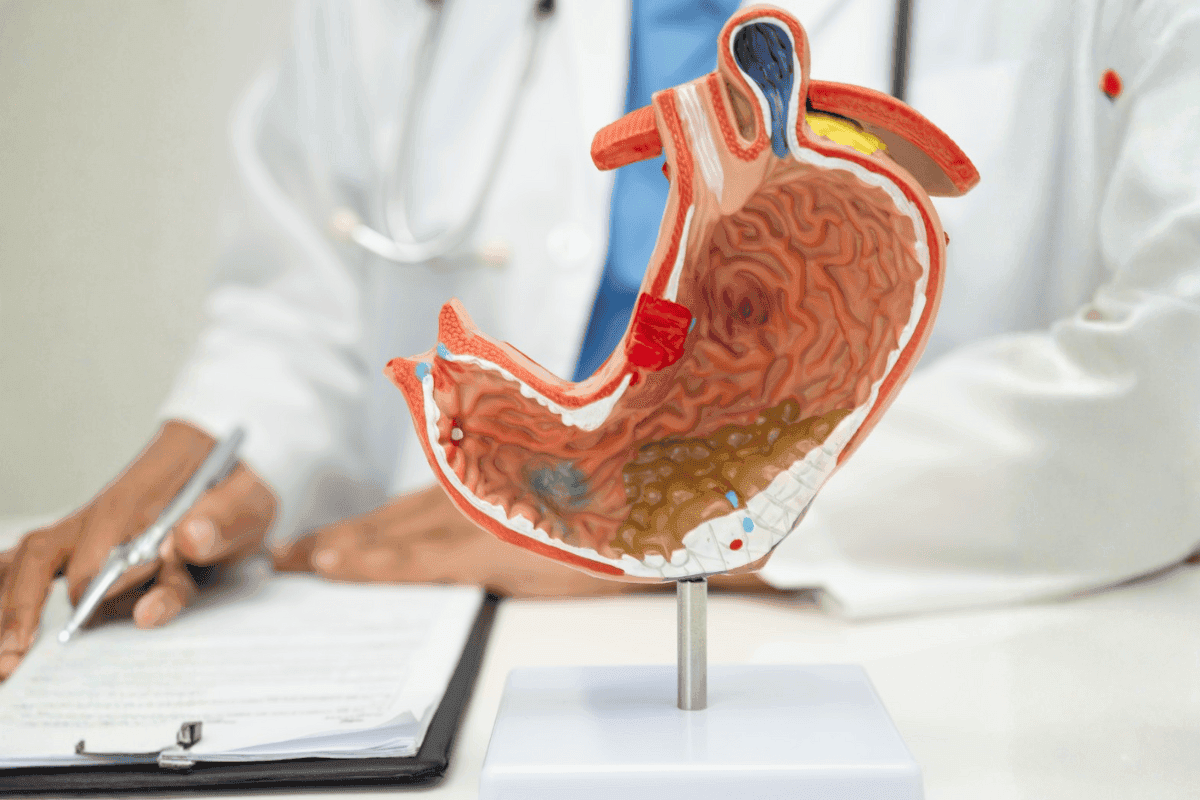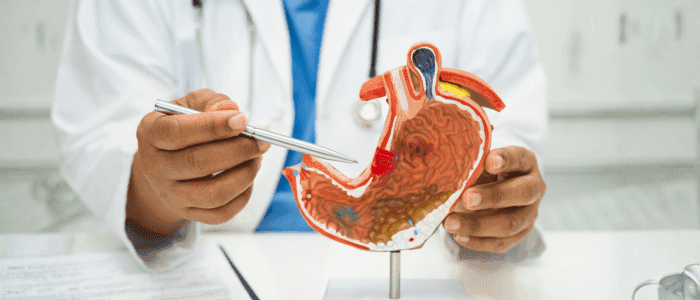Understanding Stomach Cancer Pain: Types, Areas & Management

Dr. Vrundali Kannoth• minutes•28 Oct 2025
Stomach Cancer Pain Guide: Affected Areas, Types & Relief Methods
Pain in your stomach can mean many things. An upset from spicy food. Gas. Stress. Or something that needs immediate attention.
When does stomach discomfort become a warning sign? How do you know if what you're feeling could be related to something serious like stomach cancer?
These questions matter, and they deserve clear, honest answers.
Pain is one of the most common symptoms people notice when they have stomach cancer. But not everyone experiences it the same way. Some feel a dull ache that won't go away. Others have sharp, sudden pains. Some notice it only after eating.
Understanding stomach cancer pain
First, let's be clear: not all stomach pain means cancer. In fact, most stomach pain isn't cancer at all. It could be stomach flu, indigestion, ulcers, or dozens of other conditions.
So, does stomach cancer cause pain? Yes, it often does. But pain alone doesn't confirm cancer. And the absence of pain doesn't mean you're in the clear either.

When pain does occur, it happens because the tumour affects your stomach in specific ways. It might press against the stomach wall. It could cause inflammation. It might interfere with how food moves through your digestive system. Sometimes it spreads to nearby areas, causing pain in unexpected places.
Stomach cancer pain areas and locations
Where exactly does stomach cancer pain location typically occur? This varies based on where the tumour is growing and how advanced it is.
Common stomach cancer pain location

- •Upper abdomen:This is the most typical stomach cancer pain area. You may experience discomfort in the upper middle part of your abdomen, just below your rib cage. This is where your stomach sits, so it makes sense that pain would show up here first.
- •Stomach cancer pain under ribs:Many patients describe discomfort or fullness beneath the ribs on the left side or in the centre. This can feel like pressure or a persistent ache that doesn't respond to antacids.
- •Chest area: Sometimes:the pain radiates upward, especially if the tumour is near the top of the stomach, where it connects to your oesophagus. This can feel similar to heartburn or acid reflux.
Different stomach cancer pain areas
Here's what surprises many people: stomach cancer doesn't always hurt where you'd expect.
Can stomach cancer cause back pain? Absolutely.

Stomach cancer back pain is more common than you might think. The pain can radiate to your mid or upper back. This happens when the tumour grows large enough to press against nerves or when cancer spreads to nearby tissues.
Can stomach cancer cause upper back pain? Yes.
Stomach cancer symptoms back pain in the upper back occurs because your stomach sits close to your spine and major nerve pathways. As a tumour grows, it can affect these structures.
The challenge is that back pain is incredibly common for many reasons, such as poor posture, muscle strain, stress.
So how do you know when to worry? Look for back pain that appears alongside digestive symptoms, unexplained weight loss, or changes in appetite.
Types of stomach cancer pain

What does the pain feel like with stomach cancer? There's no single answer. Different people describe it differently, and the sensation can change as the disease progresses.
Dull ache vs sharp stomach cancer pain
Many people with stomach cancer describe a persistent dull ache. It's not excruciating. It's just... there. All the time or most of the time. This low-grade discomfort in your upper belly might feel like someone is pressing on your stomach from the inside.
Cramping or burning sensation
Some patients report cramping, like severe indigestion that won't resolve. Others describe a burning feeling similar to heartburn but more intense and persistent.
This burning sensation can be confused with acid reflux. Many people take antacids for months without realising something more serious is happening.
Persistent vs intermittent
Does stomach cancer pain come and go? It can. This is what makes it tricky.
What is stomach cancer pain like in terms of timing? Some people have constant, nagging discomfort. Others experience pain that comes in waves - worse at certain times of day or related to eating.
Stomach cancer pain symptoms
Pain rarely appears alone. Usually, it comes with other warning signs of cancer that together paint a clearer picture.
Early-stage symptoms often include:
- •Mild, vague stomach discomfort
- •Feeling full quickly when eating
- •Mild nausea or loss of appetite
- •Occasional heartburn that seems different than usual
Many people dismiss these as normal digestive issues. And often, they are. However, if symptoms persist for more than a few weeks, consult a doctor.
Late-stage symptoms are more obvious:
- 1. Severe, persistent pain in the upper abdomen or back
- 2. Significant weight loss without trying
- 3. Constant nausea or vomiting, sometimes with blood
- 4. Dark, tarry stools (indicating bleeding)
- 5. Severe fatigue and weakness
- 6. Difficulty swallowing
How stomach cancer pain connects to other symptoms
If you have stomach pain plus unexplained weight loss, take it seriously. If you have stomach pain plus persistent nausea and vomiting, see a doctor.
If you experience stomach pain along with changes in your stool, seek evaluation.
How to manage stomach cancer pain
If you've been diagnosed with stomach cancer, stomach cancer pain management becomes a crucial part of your care plan. You don't have to suffer through pain. There are effective ways to find relief.
Medical pain management options:
Your doctor can prescribe medications based on your pain level. Mild pain might respond to over-the-counter options. Moderate to severe pain often requires prescription medications, sometimes including opioids for advanced cancer.
Stomach cancer pain relief strategies include:
Dietary adjustments:
Knowing about stomach cancer foods to avoid helps reduce pain triggers. Spicy foods, acidic foods, alcohol, and caffeine often make pain worse. Eating smaller, more frequent meals puts less pressure on your stomach.
Treatment that addresses the source:
Sometimes the best pain relief comes from treating the cancer itself.
Consult the right experts for your stomach cancer pain
Stomach cancer pain is real, varied, and manageable. It shows up in different locations, feels different to different people, and changes over time.
The most important things to remember: persistent stomach pain deserves medical attention. Pain accompanied by other concerning symptoms requires prompt evaluation. And if you're diagnosed, effective stomach cancer pain management options exist.
FAQs on stomach cancer pain
Stomach cancer pain can be either constant or intermittent; it varies by individual and disease stage, though persistent or recurring pain over weeks warrants medical evaluation.
Yes, early stomach cancer pain often mimics indigestion or heartburn, which is why persistent digestive discomfort that doesn't respond to usual remedies should be checked by a doctor.
Unlike ulcer pain that may improve with food, stomach cancer pain typically worsens or persists after eating due to increased pressure and impaired digestion in the affected stomach.
Table of Content
- Stomach Cancer Pain Guide: Affected Areas, Types & Relief Methods
- Understanding stomach cancer pain
- Stomach cancer pain areas and locations
- Types of stomach cancer pain
- Stomach cancer pain symptoms
- How stomach cancer pain connects to other symptoms
- How to manage stomach cancer pain
- Consult the right experts for your stomach cancer pain
